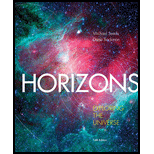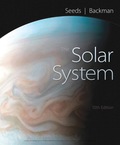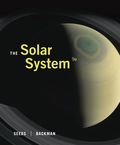
Horizons: Exploring the Universe (MindTap Course List)
14th Edition
ISBN: 9781305960961
Author: Michael A. Seeds, Dana Backman
Publisher: Cengage Learning
expand_more
expand_more
format_list_bulleted
Textbook Question
Chapter 3, Problem 5P
Draw a diagram showing Earth, the Moon, and shadows during (a) a total solar eclipse, (b) a total lunar eclipse, (c) a partial lunar eclipse, (d) an annular eclipse.
Expert Solution & Answer
Want to see the full answer?
Check out a sample textbook solution
Students have asked these similar questions
When can a total solar eclipse occur: (Give ALL correct answers, i.e., B, AC, BCD...)
A) only in spring.
B) only at new moon.
C) at any time of year.
D) anywhere on Earth.
E) only at full moon.
F) only at the equator.
The path of a total solar eclipse is modeled by
f(t)=0.00387t^2−0.481t+26.103,
where f(t) is the latitude in degrees south of the equator at t minutes after the start of the total eclipse. What is the latitude closest to the equator, in degrees, at which the total eclipse will be visible.
when a solar eclipse is observed, it must be during
Chapter 3 Solutions
Horizons: Exploring the Universe (MindTap Course List)
Ch. 3 - What is the difference between the daily and...Ch. 3 - If Earth did not rotate, could you still define...Ch. 3 - What would the seasons be like if Earth were...Ch. 3 - Why are the seasons reversed in the Southern...Ch. 3 - Prob. 5RQCh. 3 - Do the phases of the Moon look the same from every...Ch. 3 - What phase would Earth be in if you were on the...Ch. 3 - Why have most people seen a total lunar eclipse,...Ch. 3 - Why isn’t there an eclipse at every new moon and...Ch. 3 - Why is the Moon red during a total lunar eclipse?
Ch. 3 - Why should the eccentricity of Earth’s orbit make...Ch. 3 - Prob. 12RQCh. 3 - Prob. 13RQCh. 3 - How Do We know? Why must a scientific argument...Ch. 3 - You are packing for a vacation on a planet...Ch. 3 - You happen to visit the Moon when some people on...Ch. 3 - Given that Earth is about 4.6 billion (4.6109)...Ch. 3 - Identify the phases of the Moon if on March 20 the...Ch. 3 - Identify the phases of the Moon if at sunset in...Ch. 3 - Prob. 4PCh. 3 - Draw a diagram showing Earth, the Moon, and...Ch. 3 - Phobos, one of the moons of Mars, is about 25 km...Ch. 3 - A total eclipse of the Sun was visible from Canada...Ch. 3 - Prob. 8PCh. 3 - The cartoon in Figure UN 3-4 shows a crescent...Ch. 3 - The photo in Figure UN 3-5 shows the annular...
Knowledge Booster
Learn more about
Need a deep-dive on the concept behind this application? Look no further. Learn more about this topic, physics and related others by exploring similar questions and additional content below.Similar questions
- To see a total solar eclipse, an observer must be in the ___ of the Moons shadow. (17.2)arrow_forwardExamine the list of upcoming lunar eclipses in Table 3-1. What fraction of years have two eclipses?arrow_forwardWhy are solar eclipses separated by one Saros cycle not visible from the same location on Earth?arrow_forward
arrow_back_ios
arrow_forward_ios
Recommended textbooks for you

 Foundations of Astronomy (MindTap Course List)PhysicsISBN:9781337399920Author:Michael A. Seeds, Dana BackmanPublisher:Cengage Learning
Foundations of Astronomy (MindTap Course List)PhysicsISBN:9781337399920Author:Michael A. Seeds, Dana BackmanPublisher:Cengage Learning Stars and Galaxies (MindTap Course List)PhysicsISBN:9781337399944Author:Michael A. SeedsPublisher:Cengage Learning
Stars and Galaxies (MindTap Course List)PhysicsISBN:9781337399944Author:Michael A. SeedsPublisher:Cengage Learning An Introduction to Physical SciencePhysicsISBN:9781305079137Author:James Shipman, Jerry D. Wilson, Charles A. Higgins, Omar TorresPublisher:Cengage Learning
An Introduction to Physical SciencePhysicsISBN:9781305079137Author:James Shipman, Jerry D. Wilson, Charles A. Higgins, Omar TorresPublisher:Cengage Learning AstronomyPhysicsISBN:9781938168284Author:Andrew Fraknoi; David Morrison; Sidney C. WolffPublisher:OpenStax
AstronomyPhysicsISBN:9781938168284Author:Andrew Fraknoi; David Morrison; Sidney C. WolffPublisher:OpenStax


Foundations of Astronomy (MindTap Course List)
Physics
ISBN:9781337399920
Author:Michael A. Seeds, Dana Backman
Publisher:Cengage Learning

Stars and Galaxies (MindTap Course List)
Physics
ISBN:9781337399944
Author:Michael A. Seeds
Publisher:Cengage Learning

An Introduction to Physical Science
Physics
ISBN:9781305079137
Author:James Shipman, Jerry D. Wilson, Charles A. Higgins, Omar Torres
Publisher:Cengage Learning

Astronomy
Physics
ISBN:9781938168284
Author:Andrew Fraknoi; David Morrison; Sidney C. Wolff
Publisher:OpenStax

Time Dilation - Einstein's Theory Of Relativity Explained!; Author: Science ABC;https://www.youtube.com/watch?v=yuD34tEpRFw;License: Standard YouTube License, CC-BY